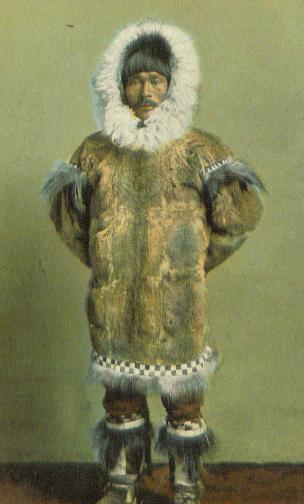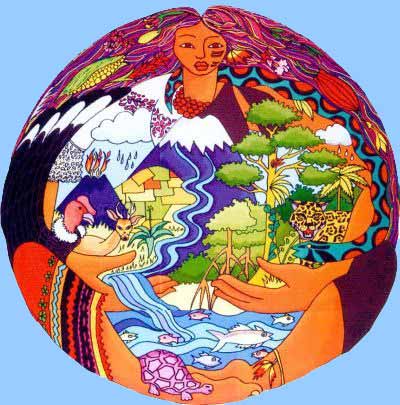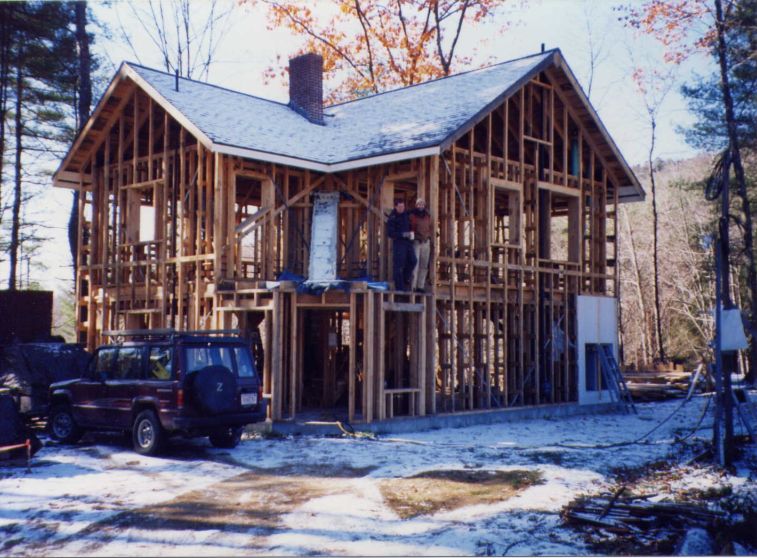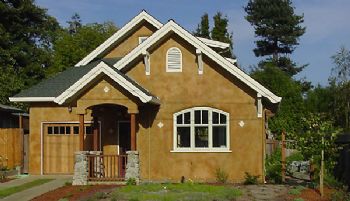Thanks, Nick. And you should take further pleasure in knowing that all these electrons are 100% recycled.
Blog Post
How to Get the Shelter We Need, and Nothing More

Not only can the earth no longer afford our petrochemical picnic cooler McMansions fueled by coal, oil, gas and nuclear power, but also, our psyches can no longer tolerate such exaggerated encapsulation.
[Editor's note: This the tenth and final piece in a set of reflections by Vermont builder Robert Riversong. Links to the other nine articles are below. Enjoy, and let us know what you think! – Tristan Roberts]
Riversong's Radical Reflections
10. Capping it All Off – Hat & boots and a good sturdy coat
In his seminal 1963 book Never Cry Wolf (made into a Disney movie in 1983), Canadian author Farley Mowat wondered how the Arctic Inuit people could live in caribou skin tents full of holes, until he realized that their primary shelter was the double-layer furred skin clothing they wore year round. Their shelters--summer tents and winter igloos--were merely secondary shelters to offer a modicum of protection from the elements while still retaining a deep connection to the environing landscape which contained and sustained them.
Mowat's other discovery, which helped turn worldwide public opinion from the myth of the "big, bad wolf" toward a deep and abiding respect for this highly social and playful animal which is at the core of the Arctic ecosystem, was that "We have doomed the wolf not for what it is, but for what we deliberately and mistakenly perceive it to be--the mythological epitome of a savage, ruthless killer--which is, in reality, no more than the reflected image of ourself."
Caged Nature and Imprisoned Humanity
The mindset which perceived the wolf as monster was the same paradigm which understood nature as wild and mean and something that needed to be tamed, controlled, and isolated from our daily "civilized" lives. This foundational myth of civilization, which led us to build fences to keep wild nature out of our domesticated spaces, also resulted in the incarceration of humanity in an entirely self-reflective world detached from the ground of our being. The more we denied the wildness of our own selves, the more we projected our suppressed carnality onto such creatures as wolves, and the more thoroughly we enclosed ourselves within both philosophical and material cages. The Inuit people shared the land with wolves and caribou, and were comfortable and content with a hooded anorak, skin trousers and a pair of mukluks--hat and boots and a good sturdy coat. We would be wise, as well, to think of our shelters as the same kind of essential wardrobe.
The Web-of-Life on a Gaian Earth
Deep ecologists, eco-psychologists, cutting-edge scientists, Earth poets and millennial philosophers are re-learning what indigenous peoples have always intuitively known: that we are part of a great Web-of-Life, inseparably intertwined and interconnected with all of the animate world and the living earth which birthed and nurtured us. To disconnect from our physical, emotional, psychological and spiritual life-support system is to invite a living death. There are no immutable boundaries in nature – all things are permeable and fluid, and all created things return to dust to become food for new creation. Our shelters need to be the same.
SUPPORT INDEPENDENT SUSTAINABILITY REPORTING
BuildingGreen relies on our premium members, not on advertisers. Help make our work possible.
See membership options »
To be truly sustainable, our homes must be built of nature's gifts – natural materials as little removed from their source and as little processed as possible. This means local, low-tech, biodegradable, permeable, respectfully harvested and crafted with care. This also means balancing our personal comfort with the needs of the ecology that surrounds us, and enhancing rather than degrading the evolutionary flow of life. That requires doing more with less, making do with simple, small and pleasant, and foregoing excess and unnecessary architectural elaboration.
In his stunning thesis about "the original affluent society" (1968), anthropologist Marshall Sahlins revealed two approaches to well-being. Hunter-gatherer societies engaged in what he called the "Zen road to affluence" – desiring little and having all needs easily met. By contrast, in modern society "man's wants are great, not to say infinite, whereas his means are limited...and the gap between means and ends can eventually be narrowed by industrial productivity" but never fully satisfied.
As many of us moderns have come to appreciate, we have built a most remarkable cultural treadmill upon which we race to catch an always-receding reward. We have made ourselves into addicts of comfort and pleasure, status and wealth--and collectively and individually we exhibit all the signs and symptoms of profound addictive disorder, post-traumatic stress and chronic dis-ease.
Those who have awakened from the trance have shifted to downward mobility, or the back-to-the-land exodus (encouraged by Ralph Borsodi, whose 1934 School of Living influenced Helen and Scott Nearing) or the more recent sustainability and transition movements. The 1960s were a reprieve from "normalcy" for some, in which the constraints and shackles of society were thrown off for a more natural freedom of expression. Backlash, repression, and the horrors of war, civil unrest and serial assassinations made the moment difficult to sustain. But the cleansed "doors of perception" (Blake), along with the budding environmental movement and the first oil shock in 1973, opened the way for the pioneers of passive solar and super-insulated design and construction. I was among those intrepid explorers, having helped build a geodesic dome in 1970 and then delving into low-cost community-based housing in 1980 and specializing in passive solar double-wall houses since 1982.
The Riversong Truss

My contribution was to take John Larsen's retrofit wall truss system and turn it into a resource-efficient method of new super-insulated construction with native rough-sawn lumber – a system becoming known as the Riversong truss wall – filled with dense-pack cellulose and sealed with air-tight drywall. Another generation of innovators is bringing straw-bale and earthen building techniques into the mainstream, often coupled with traditional timber frames, returning our shelter technologies yet further toward the simple and sublime. Natural building is now incorporated into municipal, state and international green building codes.
Not only can the earth no longer afford our petrochemical picnic cooler McMansions fueled by coal, oil, gas and nuclear power, but also, our psyches can no longer tolerate such exaggerated encapsulation, such inviolable distinction between private and public space, or such wasteful and unsatisfying extravagance. Our physiology is deteriorating, our relationships dismembering, our societies disintegrating, as we wander aimlessly in a spiritual wasteland of our own creation.

More than a house, what we truly need is a sense of home – of being at home in a welcoming and generous world which offers a framework within which we can evolve into the animate creatures we have always been. Whole and wholesome and hearty and hale.
For what does shelter truly require? A sound roof, a solid foundation and sturdy walls. A broad hat to deflect the worst of the rain and wind, a tall pair of boots to keep us out of the mud, and a sturdy coat to wrap us against the cold. Enough and no more.
1. Context – land, community & ecology
2. Design – elegant simplicity, the Golden Mean
3. Materials – the Macrobiotics of building: natural, healthy and durable
4. Methods – criteria for appropriate technology
5. Foundations – it all starts here: how do we begin?
6. Envelope – shelter from the storm, our third skin
7. HVAC – maintaining comfort, health and homeostasis
8. Energy & Exergy – sources and sinks
9. Hygro-Thermal – the alchemy of mass & energy flow
10. Capping it All Off – hat & boots and a good sturdy coat
copyleft by Robert Riversong: may be reproduced only with attribution for non-commercial purposes
Robert Riversong has been a pioneer in super-insulated and passive solar construction, an instructor in building science and hygro-thermal engineering, a philosopher, wilderness guide and rites-of-passage facilitator. He can be reached at HouseWright (at) Ponds-Edge (dot) net. Some of his work can be seen at BuildItSolar.com (an article on his modified Larsen Truss system), GreenHomeBuilding.com (more on the Larsen Truss), GreenBuildingAdvisor.com (a case study of a Vermont home), and Transition Vermont (photos).
Published July 15, 2011 Permalink Citation
(2011, July 15). How to Get the Shelter We Need, and Nothing More. Retrieved from https://www.buildinggreen.com/blog/how-get-shelter-we-need-and-nothing-more
Comments
Great stuff! good to see thes
Great stuff! good to see these thoughts vocalised, err, digitized



Add new comment
To post a comment, you need to register for a BuildingGreen Basic membership (free) or login to your existing profile.